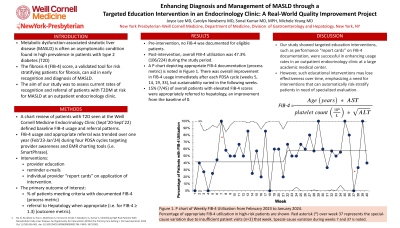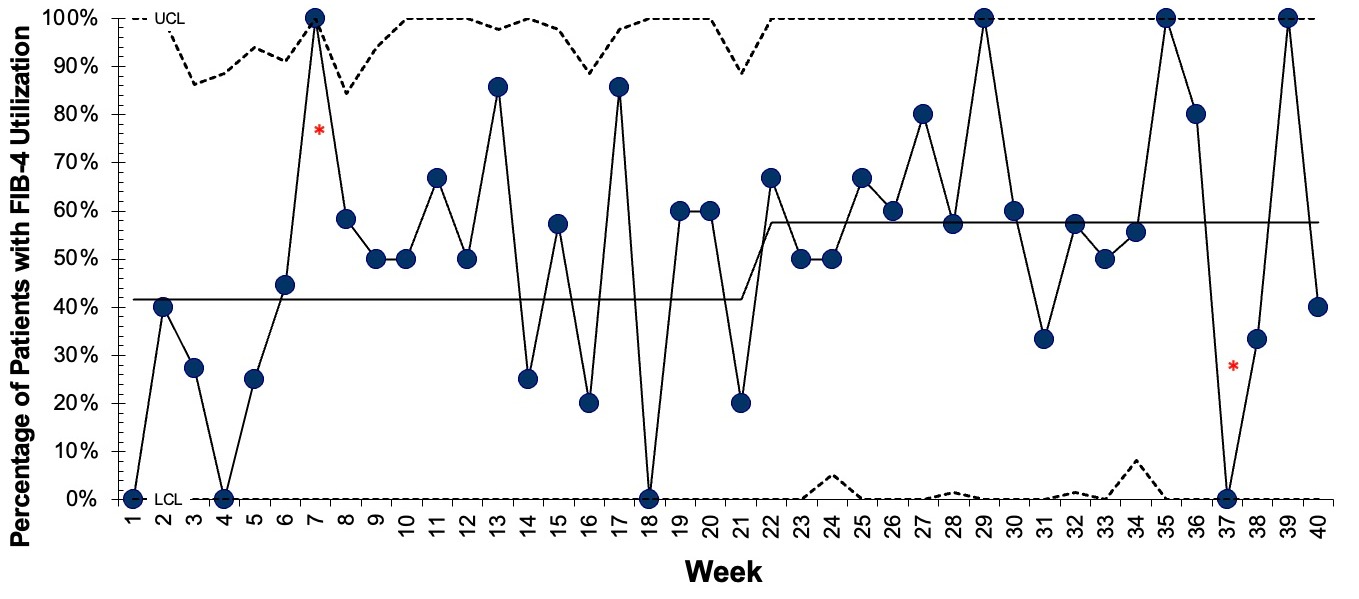Tuesday Poster Session
Category: Liver
P4621 - Enhancing Diagnosis and Management of Metabolic Dysfunction-Associated Steatotic Liver Disease (MASLD) Through a Targeted Education Intervention in an Endocrinology Clinic: A Real-World Quality Improvement Project
Tuesday, October 29, 2024
10:30 AM - 4:00 PM ET
Location: Exhibit Hall E

Has Audio

Joyce Lee, MD
New York-Presbyterian / Weill Cornell Medical Center
Boston, MA
Presenting Author(s)
Joyce Lee, MD1, Carolyn Newberry, MD2, Michele Yeung, MD3, Sonal Kumar, MD, MPH4
1New York-Presbyterian / Weill Cornell Medical Center, Boston, MA; 2New York-Presbyterian / Weill Cornell Medical Center, New York, NY; 3Weill Cornell Medicine, New York, NY; 4Weill Cornell Medical College, New York, NY
Introduction: Metabolic dysfunction-associated steatotic liver disease (MASLD) is often an asymptomatic condition found in high prevalence in patients with type 2 diabetes. The fibrosis 4 (FIB-4) score, a validated tool for risk stratifying patients for fibrosis, can aid in early recognition and diagnosis of MASLD. However, FIB-4 is underutilized in the outpatient endocrinology setting. The aim of our study was to assess current rates of recognition and referral of diabetic patients at risk for MASLD at an outpatient endocrinology clinic, and to enhance these rates via an education-based multi-faceted implementation strategy to improve FIB-4 usage and referral to Hepatology in high-risk patients.
Methods: A chart review of patients with type 2 diabetes seen at the Weill Cornell Medicine Endocrinology Clinic (Sept’20-Sept’22) defined baseline FIB-4 usage and referral patterns. FIB-4 usage and appropriate referral was trended over one year (Feb'23-Jan'24) during four PDSA cycles targeting provider awareness and EMR charting tools (i.e. SmartPhrase). Interventions included provider education, reminder e-mails, and individual provider “report cards” on application of intervention. The primary outcome of interest was percentage of patients meeting criteria with documented FIB-4 in the EMR (process metric) and referral to Hepatology when appropriate (i.e. for FIB-4 ≥ 1.3) (outcome metric).
Results: Pre-intervention, there was no FIB-4 documented for eligible patients. Post-intervention, overall FIB-4 utilization was 47.3% (106/224) during the study period. A P chart depicting appropriate FIB-4 documentation (process metric) during the study is noted in Figure 1. We found overall improvement in FIB-4 usage compared to baseline immediately after each PDSA cycle (weeks 5, 14, 19, 33), but sustainability varied in the following weeks. Special-cause variation during weeks 7 and 37 is noted. We also found that 15% (7/45) of overall patients with elevated FIB-4 scores were appropriately referred to hepatology, an improvement from the baseline of 0.
Discussion: Our study showed targeted education interventions, such as performance “report cards” on FIB-4 documentation, were successful in enhancing usage rates in an outpatient endocrinology clinic at a large academic medical center. However, such educational interventions may lose effectiveness over time, emphasizing a need for interventions that can automatically risk-stratify patients in need of specialized evaluation.

Disclosures:
Joyce Lee, MD1, Carolyn Newberry, MD2, Michele Yeung, MD3, Sonal Kumar, MD, MPH4. P4621 - Enhancing Diagnosis and Management of Metabolic Dysfunction-Associated Steatotic Liver Disease (MASLD) Through a Targeted Education Intervention in an Endocrinology Clinic: A Real-World Quality Improvement Project, ACG 2024 Annual Scientific Meeting Abstracts. Philadelphia, PA: American College of Gastroenterology.
1New York-Presbyterian / Weill Cornell Medical Center, Boston, MA; 2New York-Presbyterian / Weill Cornell Medical Center, New York, NY; 3Weill Cornell Medicine, New York, NY; 4Weill Cornell Medical College, New York, NY
Introduction: Metabolic dysfunction-associated steatotic liver disease (MASLD) is often an asymptomatic condition found in high prevalence in patients with type 2 diabetes. The fibrosis 4 (FIB-4) score, a validated tool for risk stratifying patients for fibrosis, can aid in early recognition and diagnosis of MASLD. However, FIB-4 is underutilized in the outpatient endocrinology setting. The aim of our study was to assess current rates of recognition and referral of diabetic patients at risk for MASLD at an outpatient endocrinology clinic, and to enhance these rates via an education-based multi-faceted implementation strategy to improve FIB-4 usage and referral to Hepatology in high-risk patients.
Methods: A chart review of patients with type 2 diabetes seen at the Weill Cornell Medicine Endocrinology Clinic (Sept’20-Sept’22) defined baseline FIB-4 usage and referral patterns. FIB-4 usage and appropriate referral was trended over one year (Feb'23-Jan'24) during four PDSA cycles targeting provider awareness and EMR charting tools (i.e. SmartPhrase). Interventions included provider education, reminder e-mails, and individual provider “report cards” on application of intervention. The primary outcome of interest was percentage of patients meeting criteria with documented FIB-4 in the EMR (process metric) and referral to Hepatology when appropriate (i.e. for FIB-4 ≥ 1.3) (outcome metric).
Results: Pre-intervention, there was no FIB-4 documented for eligible patients. Post-intervention, overall FIB-4 utilization was 47.3% (106/224) during the study period. A P chart depicting appropriate FIB-4 documentation (process metric) during the study is noted in Figure 1. We found overall improvement in FIB-4 usage compared to baseline immediately after each PDSA cycle (weeks 5, 14, 19, 33), but sustainability varied in the following weeks. Special-cause variation during weeks 7 and 37 is noted. We also found that 15% (7/45) of overall patients with elevated FIB-4 scores were appropriately referred to hepatology, an improvement from the baseline of 0.
Discussion: Our study showed targeted education interventions, such as performance “report cards” on FIB-4 documentation, were successful in enhancing usage rates in an outpatient endocrinology clinic at a large academic medical center. However, such educational interventions may lose effectiveness over time, emphasizing a need for interventions that can automatically risk-stratify patients in need of specialized evaluation.

Figure: P Chart - Percentage of High-Risk Patients with FIB-4 Utilization
Disclosures:
Joyce Lee indicated no relevant financial relationships.
Carolyn Newberry: Nestle Nutrition Institute – Consultant.
Michele Yeung indicated no relevant financial relationships.
Sonal Kumar: Intercept Pharmaceuticals, Inc. – Advisory Committee/Board Member, Speaker and site PI.
Joyce Lee, MD1, Carolyn Newberry, MD2, Michele Yeung, MD3, Sonal Kumar, MD, MPH4. P4621 - Enhancing Diagnosis and Management of Metabolic Dysfunction-Associated Steatotic Liver Disease (MASLD) Through a Targeted Education Intervention in an Endocrinology Clinic: A Real-World Quality Improvement Project, ACG 2024 Annual Scientific Meeting Abstracts. Philadelphia, PA: American College of Gastroenterology.
